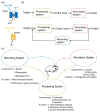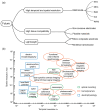Optogenetic Brain-Computer Interfaces
- PMID: 39199779
- PMCID: PMC11351350
- DOI: 10.3390/bioengineering11080821
Optogenetic Brain-Computer Interfaces
Abstract
The brain-computer interface (BCI) is one of the most powerful tools in neuroscience and generally includes a recording system, a processor system, and a stimulation system. Optogenetics has the advantages of bidirectional regulation, high spatiotemporal resolution, and cell-specific regulation, which expands the application scenarios of BCIs. In recent years, optogenetic BCIs have become widely used in the lab with the development of materials and software. The systems were designed to be more integrated, lightweight, biocompatible, and power efficient, as were the wireless transmission and chip-level embedded BCIs. The software is also constantly improving, with better real-time performance and accuracy and lower power consumption. On the other hand, as a cutting-edge technology spanning multidisciplinary fields including molecular biology, neuroscience, material engineering, and information processing, optogenetic BCIs have great application potential in neural decoding, enhancing brain function, and treating neural diseases. Here, we review the development and application of optogenetic BCIs. In the future, combined with other functional imaging techniques such as near-infrared spectroscopy (fNIRS) and functional magnetic resonance imaging (fMRI), optogenetic BCIs can modulate the function of specific circuits, facilitate neurological rehabilitation, assist perception, establish a brain-to-brain interface, and be applied in wider application scenarios.
Keywords: brain–computer interface; electrode; multimodal; optogenetic.
Conflict of interest statement
The authors declare no conflict of interest.
Figures



References
-
- Rao R.P., Scherer R. Brain-computer interfacing. IEEE Signal Process. Mag. 2010;27:150–152. doi: 10.1109/MSP.2010.936774. - DOI
Publication types
Grants and funding
LinkOut - more resources
Full Text Sources
Miscellaneous

